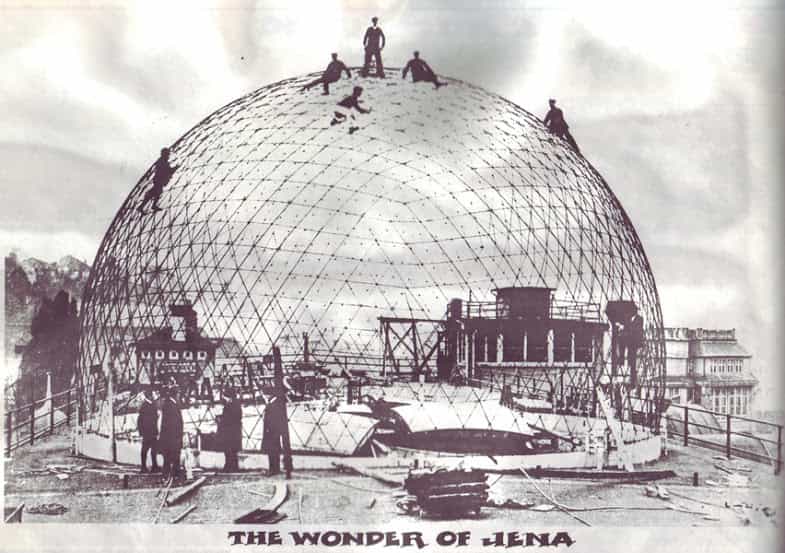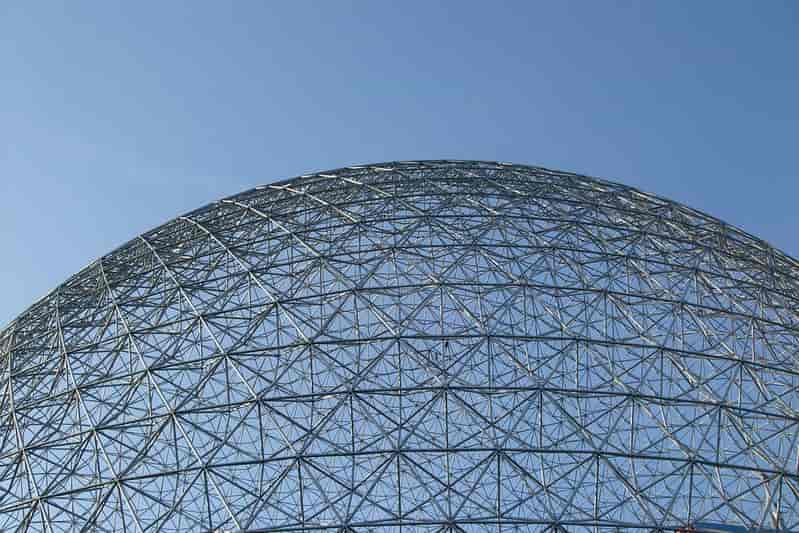Geodesic Dome: An Invention that changed the World!
A Geodesic Dome can be simply termed a spherical form in which triangular faces are very lightweight produce and distribute tension among the structure. R Buckminster Fuller designed this transformative structure in 1940.
Introduction
- The geodesic dome is a sphere-like structure consisting of triangles that provide a self-balancing structural framework that uses minimal materials.
- The word “geodesic” is a Latin word that means ‘earth dividing’.
- It was the result of trying to build affordable and efficient housing after World War II.
- These structures can be easily formed and removed. Therefore, are highly efficient for temporary structures.
- These structures can be formed without the requirement of internal columns for large spaces.
- After designing the first commercial dome for the Ford Motor Company headquarters in Michigan in 1953, Buckminster Fuller received the patent for the dome a year later.

The Concept behind the Geodesic Dome
- The geodesic dome geometry was totally based on the phenomena that differenciates the stregth of a rectangle and triangular structural elements.
- Triangular structures came out to be twice as strong as the rectanglular ones. Moreover, triangular structures came out to be more rigid.
- The above mentioned princuple became responsible for the invension of a Geodesic Dome.
- Further, Fuller also discovered the unparalleled strength of a spherical structure when combined with triangular elements.
- The sphere enclosed the largest volume of interior space, using the least amount of surface area. Therefore, saving on materials and cost, explaining the benefits of this amazing structure.
- Fuller also found out that the square footage area of the dome becomes 4 times, and the volume becomes 8 times, when its diameter is doubled.
Shelter creation using Geodesic Dome
- The Geodesic Dome design was more comfortable and efficient in terms of its architecture.
- The shelter by this design was more economically viable and abundantly available to all classes of the people.
- Moreover, Fuller also designed the interior services, like the toilet (inspired by airplanes), the shower (cleans more efficiently with less water consumption), and the bathroom for this structure.
- Buckminster Fuller also tried to study all the futuristic materials rather than being dependent on conventional materials like glass, brick, or wood for his structure.
- The weight-reduction of the materials used made the structure more mobile in nature.
- Due to its high strength-to-weight ratio and futuristic approach, the structure came out to be hurricane resistant also.
- The design of the dome also gives the structure a properly ventilated airy space, free of any columns to support the interior structure.
- Shelters designed on this concept have been built all around the world in different climates and temperatures. Moreover, it turned out to be highly efficient for almost every environment.
Geodesic Dome: An Energy-Efficient Structure
- These domes are based on a network of triangles, which in itself is a highly stable shape. This also implies that geodesic dome buildings are strong as well as earthquakes, snow, and wind resistance.
- A geodesic structure also encloses larger volumes with less surface area than any traditional structure. This simply implies a lesser area to expose to external heat and cold, therefore, saving on electrical consumption.
- Moreover, the construction of geodesic domes is a fast process. It is generally done using prefabricated components.
- Extreme wind turbulence is also very less in the case of a geodesic dome design due to its efficient structure.
- The architecture of the dome structure also automatically acts as a big reflector that reflects and controls the interior heat generation. This helps in preventing radiant heat loss.
- Moreover, the net annual energy savings for a dome owner is 30% less than normal rectilinear homes according to a survey.
- The requirement of lesser material than usual building construction also increases the potential of being a structurally efficient design.
Uses of Geodesic Domes:
- Sports stadiums.
- Theatres.
- Greenhouses.
- Exhibition halls.
- Children’s playgrounds.
- Emergency shelters.
- Military Emergency shelters.
- Mobile military housing
- Radomes.
Why Use Geodesic Domes?
- Pre-fabrication of the building elements
- Easy removing and reinstalling
- Usable for better area usage at small or large booths.
- High-resistance to corrosion
- Easy usability of solar energy
- Economically viable for minimal usage of installation parts
- Not being dependent on weather conditions
- Ability to repair and easy maintenance
- Covering large spans with a minimum thickness
Materials used for making Geodesic Domes
- Timber, PVC or galvanized frames covered with a thin architectural membrane (such as PVC polyester or ETFE foil) can be used for simple, movable geodesic dome designs.
- Sports Stadiums have also featured aluminum and steel frames, covered with materials such as copper, aluminum, and acrylic panels, which would be more permanent and sturdy in nature.
- Geodesic Dome architecture, being efficient, inexpensive, and durable, corrugated metal dome feature all around the world.
- Plastic and fiberglass domes also helpful for sensitive radar zones in Arctic regions and for weather stations around the world.
Examples of Geodesic Domes
- American exhibit at Expo 67, Montreal.
- Epcot Centre’s Spaceship Earth Centre, Florida
- Tacoma Dome, Washington State
- The Aviary at Queen’s Zoo, US.
- Eco Camp Patagonia hotel – the first geodesic dome hotel, Chile.
- The biomes, Eden Project, Cornwall, UK.
- Biosphere desert project in Arizona
- Eden Project, Britain

There are more than 300,000 geodesic domes worldwide that are in workable and livable conditions. They can be constructed in a variety of sizes, with the largest being the 216m diameter Fukuoka Dome, a baseball stadium in Japan.
If you want to build a geodesic dome of your own, follow these illustrative steps.





One thought on “Geodesic Dome: An Invention that changed the World!”
Comments are closed.